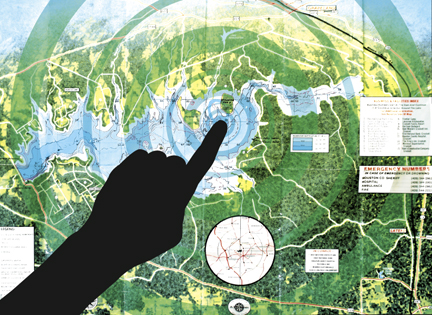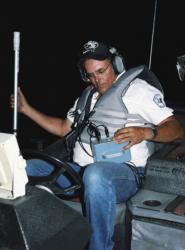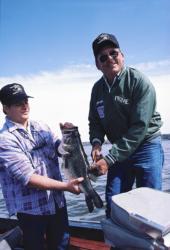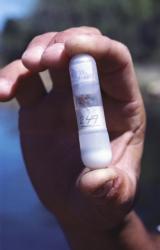Bass that go ‘beep’
One angler’s research sheds light in the darkness that is big bass behavior

Every bassin’ buff has a theory on what makes big fish tick. But for John Hope, the proof is in the pudding.
Hope was a fishing guide at Houston County Lake in East Texas in the late 1980s and 1990s. He hauled in his share of lunker largemouths during that period and watched as many others were reeled in from the rear deck of his bass boat.
As Hope’s big-bass prowess became sharper, he became increasingly curious about their mysterious behavior patterns. The guide eventually became so obsessed with big bass that he began equipping them with electronic transmitters, so he could monitor their daily routines.
Between 1986 and 1994, Hope surgically implanted thumb-sized electronic transmitters inside 57 bass ranging in size from 6 pounds to more than 15 pounds.
A handful of the study fish where “ShareLunkers” – 13-pound-plus bass caught from Texas lakes and donated to the Texas Parks and Wildlife Department for use in its well-known spawning and genetics research program.
Using high-tech, radio-telemetry tracking gear, Hope monitored “beeping” fish in 15 different lakes ranging in size from 100 acres to 114,000 acres. He funded the studies entirely with money from his own pocket.
The transmitters cost him $150 each. He went through three sets of tracking gear, which cost $3,000 each.
Most of Hope’s research lakes were in Texas, but he also tracked fish at Truman Reservoir in Missouri. The ShareLunker candidates included a 15-pounder from Lake Fork, a 14-pounder from Lake Murvaul and a 13-pounder from Sam Rayburn. Hope also planted a transmitter inside a 13-pounder at Houston County and a 7-pound smallmouth at Lake Whitney. At the time, the bronzeback was the No. 2 fish on Texas’s top-50 list for that species.
 Hope worked on the project with the diligence of a man on a mission. He once spent five-consecutive days and nights with his earphones on at Houston County, a 1,500-acre reservoir near Crockett, Texas.
Hope worked on the project with the diligence of a man on a mission. He once spent five-consecutive days and nights with his earphones on at Houston County, a 1,500-acre reservoir near Crockett, Texas.
The guide slept in the bottom of his boat in a sleeping bag, waking periodically to document the movements of his finny subjects. He came to shore once a day to eat and bathe.
Hope took his tracking study to the next level at Lake Amistad, a 60,000-acre lake on the Texas/Mexico border. He lived in a motel for a full year. Clad in scuba gear, he trailed along behind four different bass up to 11 pounds each day and night.
Hope has tracked big bass in temperatures as cold as 28 degrees, as hot as 110 degrees and in raging thunderstorms. He was serious about the game, indeed.
The objectives?
Hope wanted to learn as much as possible about trophy bass and make a name for himself in the fishing industry. His ultimate goal was to make money by sharing his findings and to attract more guide clients.
Most folks were intrigued by Hope’s study. Others felt threatened by it.
Hope said some Lake Fork fishing guides screamed so loud that TPWD created a fish-tracking permit and implemented a rule that made it illegal to have a guide license and a fish-tracking permit at the same time.
“The TPWD pulled my guide license because a group of fishing guides thought I had an unfair advantage,” Hope said.
For years, Hope wrote about his findings in a monthly column he wrote for a popular Texas magazine geared toward trophy bass fishing. The standing column was fittingly titled “Trackin’ Texas Trophies.” He also performed speaking engagements and worked closely with TPWD fisheries biologists more than once.
Hope’s tracking study eventually lead to a job as host of a television program dedicated to Texas fishing. The job consumed so much time that he couldn’t continue the project any longer.
But it really didn’t matter. By that time, Hope’s research had begun to repeat itself. He didn’t need a degree in fisheries biology to interpret the data.
“A big bass is a big bass, no matter where the lake is,” he said. “After a fish reaches 7 pounds, it does the same things and goes to the same places, everyday. It makes no difference if it’s 7 pounds or 18 pounds.”
I have fished with Hope on several occasions on a number of lakes. The trip I remember most took place at Houston County Lake on a moonlit August night in 1986.
We were spying on “Wanda,” the fish that started the program.
 Wanda was a 10-pounder Hope caught in March of 1985. The guide documented the bass’s movements for three years.
Wanda was a 10-pounder Hope caught in March of 1985. The guide documented the bass’s movements for three years.
Amazingly, Hope caught and released Wanda four additional times (twice during the spawn) during that period, and his son-in-law caught her once.
Sadly, the big bass was eventually caught and mounted by another angler. She tipped the scale at 12 pounds, 13 ounces at final weigh-in.
Hope learned a passel of lessons from Wanda. Interestingly, the findings were mirrored by every fish in the study that weighed 7 pounds or more.
One of the more valuable lessons is that big bass are home bodies. Hope said once a big bass establishes a home range, it maintains that range for life.
“Every big bass has a bedroom where it rests and a kitchen where it feeds,” Hope said. “And those places won’t be very far apart. I never had a fish move more than 400 yards from its bedroom when it went to feed. They don’t go roaming around all over the lake from one day to the next.”
Hope also learned that big bass feed predominantly at night, 12 months a year.
“Every fish over 7 pounds is a nocturnal feeder,” Hope said. “They may feed periodically during the day. But they do most of their feeding at night, usually in two-hour intervals. They feed for a while and then rest for a while.”
Wanda spent a high percentage of her “slack time” suspended over 20 feet of water along the edges of Little Elkhart Creek.
When the fish did go on the prowl – presumably feeding – she always headed for a nearby shoreline. The bass cruised up and down the same 100-yard stretch of bank repeatedly.
Hope said Wanda was so predictable he could set his watch by her movements.
“She would suspend in her bedroom most of the day, and then she would crank up 30 minutes before dark and feed all night long,” Hope said. “Thirty minutes after daylight, she went straight back to her bedroom. Every tracked bass over 7 pounds operated pretty much the same way.”
Each time Hope caught Wanda (outside of the spawn), she was actively cruising her kitchen. The bass refused to bite when she was in her bedroom, suspended over deep water. When it did come time to spawn, Wanda always dumped her eggs on the same flat, year after year.
Data collected on several tournament-caught bass on 114,000-acre Sam Rayburn Reservoir adds more clout to Hope’s home-body theory. It also firms up his belief that a bass is a bass, regardless of the size of the pond.
 The Sam Rayburn fish – all 6- and 7-pounders – were caught north of the State Highway 147 Bridge and taken 18 miles south to Twin Dikes Marina for weigh-in. That’s where Hope planted the transmitters and released the fish.
The Sam Rayburn fish – all 6- and 7-pounders – were caught north of the State Highway 147 Bridge and taken 18 miles south to Twin Dikes Marina for weigh-in. That’s where Hope planted the transmitters and released the fish.
Hope relocated his study fish a week later. Amazingly, all but one of them had made the 18-mile journey back home. They were positioned in the same areas where they were caught a week earlier.
Hope assumes the transmitter fouled on the lost bass, or that the fish was caught and kept by another angler.
Hope’s army of beeping bass also shed some valuable data linked to how fish relate to cover and structure in shallow, mid-range and deep water. Furthermore, they also helped him firm up his “funnel point” theory.
“For several years, I would mark an `X’ on the map when I would catch a big bass,” Hope explained. “At the time, the only common denominators I noticed between the spots were deepwater access, cover and structure.”
Hope was referencing the X-riddled map one day when he made an interesting discovery.
“It was like someone flipped on a light,” he said. “There was a narrow trail or `funnel’ leading to all the X’s. They looked like funnels – wide at one end, narrow on the other. These are the types of places big bass like to travel. Spend more time fishing defined funnel points, and you’ll catch more big bass.”
Hope put his theory to the test on a rainy afternoon at Houston County in February of 1987. He announced to a room full of outdoor writers, bait manufacturers and fishing guides that he could look at a lake map and mark 10 spots where trophy bass had been caught before.
Two of the guides were from Lake Murvaul; an East Texas big-bass lake Hope had never visited before. One of the guides produced a Murvaul map and Hope pulled out a Sharpie.
“After they all stopped snickering, I marked 10 spots, gave the map back to the guides and asked them to be honest,” Hope said. “Both of them admitted they had either caught big ones off the 10 spots, or knew of someone who had.”
Hope, eventually produced an 81-page book, “Trackin’ Texas Trophies.”
The paperback chronicles his years of research and summarizes valuable knowledge gained through countless hours spent monitoring big bass during all hours of the day and night, during all seasons of the year and in pleasant and foul weather conditions alike.